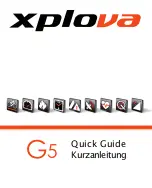
Checks and inspections
31
Checks and inspections
Please keep to the following inspection plan – it ensures that the most important checks are done
at the best possible times. It also ensures that you have no doubts about what you have to do and
when. The setup and functionality of the bicycle could change during transport – despite multiple
checks being carried out during production and the final post-production check. Therefore, check the
following before the first ride:
Screws, bolts and pedals are all secure
•
Stem, handlebars and seat post are all safely secured and adhere to the minimum insertion length
•
Test the setup of the brakes and their effectiveness
•
Check that the wheels and quick releases are secured
•
Check that the suspension components are working properly
•
Gears and lights
•
Air pressure and tires
•
Generally, a bicycle will change most in the first 100 kilometers; the spokes will bed in, the brake
cables and gear cables settle into the housings and the bearings are broken in.
Therefore, it is important that you have your first inspection carried out by your specialist retailer
after 200 – 300 kilometers or 4 – 6 weeks. This should encompass:
Checking the wheels, which should be tensed and centered if required
•
Oiling the chain and gear system
•
Checking that screws, bolts and quick releases are secured
•
Checking the torques (pedals, cranks, handlebars, seat)
•
Checking the headset, brakes, gears and suspension parts, adjusting them where necessary
•
All wear parts checked and replaced if required. In particular, this includes the brake friction
•
partners (brake rubbers, brake pads, brake discs and rims).
Other inspections and checks should be carried out:
After every ride
•
After rides in rainy or muddy conditions
•
After around 300 to 500 kilometers
•
After one year
•
After 3000 kilometers
•
Before and after every ride
Check that:
The lights and bell work and are safely secured
•
The brakes are working safely and are secured
•
The tires have not picked up any foreign objects or damage and that the rims are not damaged
•
and are still running true (particularly after off-road rides)
The suspension parts are working and are safely secured
•
The gears are working properly and are safely secured
•
The quick releases are tight
•
The frame and fork have not been deformed or damaged
•
If you are not certain that your bicycle is in perfect technical condition, you should have it checked
by an expert!
After rides in rainy or muddy conditions:
Clean the chain, gears and brakes, and apply oil to the chain.
After riding 300–500 km or after 3–6 months:
Clean your bicycle and oil the moving parts, excluding the brakes
•
Repair any damaged paintwork
•
Treat areas of rust or exposed metal areas
•
Replace damaged or broken components
•
Check the chain, front and rear chainrings, brake pads and rims for wear
•
Check that all screws, bolts and quick releases are tight
•
After 1 year:
The measures undertaken in the first inspection should be repeated. That means:
Cleaning the bicycle
•
Oiling the chain and gear system
•
Checking that screws, bolts and quick releases are secure
•
Checking the torques (pedals, cranks, handlebars, seat)
•
Checking the headset, brakes, gears and suspension parts, adjusting them where necessary
•
After 3000 kilometers:
A general inspection is once again due. That means that important parts of your bicycle should be
checked over by your specialist retailer to see if they are working properly, secure, oiled or perhaps
need replacing. That includes checking hubs and pedals, wheels as well as the headset, gear
cables and brake cables.
As with all mechanical components, your bicycle is subjected to high stress and wear. Various
materials and parts may react differently when subjected to wear and high levels of stress.
All of your bicycle components are designed to withstand a certain amount of strain and have
a certain lifecycle. If this lifecycle is exceeded, it could result in accidents and serious injuries. You
should therefore regularly check whether changes or cracks appear on your bicycle. If this is the
case, allow the specialist retailer to check the bicycle and replace any possibly damaged parts.
Instructions for care and maintenance
Screws and torque wrenches
When working on your bicycle, please ensure in particular that all screws that are key to safety are
secured with the correct torque. The required torque is printed on many components.
This amount is stated in Newton meters (Nm) and should be adjusted using a torque wrench. The
best sort of torque wrench for this is one that clicks when it reaches the prescribed torque. Otherwi-
se screws can snap or break. This could result in accidents and serious falls.
If you don’t own a torque wrench then you should always leave this work up to a specialist retailer!
A table listing the most important torques for bolted connections is provided in the “Technical
information” chapter.
Care and maintenance
Care and maintenance is a very important topic because you will only be able to enjoy your bicycle
for years to come if you give it the required care and attention. And this also has a major bearing on
its functionality, safety and warranty.
Содержание DHM
Страница 1: ......
Страница 19: ...Technology 19 Operation of front derailleur levers FD 6700 ...
Страница 20: ...Technology 20 Installation of the brake cable ...
Страница 21: ...Technology 21 ...
Страница 26: ...Technology 26 SIS Adjustment ...
Страница 29: ...Technology 29 Installation of the hub to the frame ...
Страница 30: ...Technology 30 General Safety Information Narrow type chain ...
Страница 37: ......
Страница 38: ...HM Bike Consulting GmbH ch des Prés 21 CH 1279 Chavannes de Bogis www hmbike com ...








































